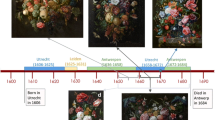Abstract
The following SEM and TEM images were taken by late Dr. Hiroshi Nakahara many years ago, left unpublished, and shown on the screen during lunchtimes in the symposium. He graduated from the course of zoology of the Faculty of Sciences, University of Hokkaido, and studied abroad in the University of New York and School of Dentistry, University of Texas. After returning home, he taught oral anatomy at Meikai University, School of Dentistry (former Josai Dental University). Using electron microscopes both SEM and TEM, he studied the mineralization processes of a variety of shellfish as well as vertebral hard tissues such as tooth enamel, dentin, and bone.

Dr. Hiroshi Nakahara (1928–2001)
You have full access to this open access chapter, Download conference paper PDF
Similar content being viewed by others
Keywords
- Bone
- Ligament
- Monodonta confusa
- Nacreous layer
- Otolith
- Pearl
- Pinctada fucata
- Prismatic layer
- Tooth enamel
TEM of nacre formation of Calliostoma unicum. (a) Central portion of the pyramid-shaped stacks shows empty space. (b–e) Sections were nearly parallel to the surface. Each tablet is divided into sectors (b and c). Organic cores remained at the center of stacks in the stained sections (d and e) (bars: a = 2.2 μm, b = 5 μm, c = 10 μm, d = 10 μm, e = 1 μm)
Author information
Authors and Affiliations
Corresponding author
Editor information
Editors and Affiliations
Rights and permissions
Open Access This chapter is licensed under the terms of the Creative Commons Attribution 4.0 International License (http://creativecommons.org/licenses/by/4.0/), which permits use, sharing, adaptation, distribution and reproduction in any medium or format, as long as you give appropriate credit to the original author(s) and the source, provide a link to the Creative Commons license and indicate if changes were made.
The images or other third party material in this chapter are included in the chapter's Creative Commons license, unless indicated otherwise in a credit line to the material. If material is not included in the chapter's Creative Commons license and your intended use is not permitted by statutory regulation or exceeds the permitted use, you will need to obtain permission directly from the copyright holder.
Copyright information
© 2018 The Author(s)
About this paper
Cite this paper
Kakei, M. (2018). Selected SEM and TEM Images by Late Dr. Hiroshi Nakahara. In: Endo, K., Kogure, T., Nagasawa, H. (eds) Biomineralization. Springer, Singapore. https://doi.org/10.1007/978-981-13-1002-7_43
Download citation
DOI: https://doi.org/10.1007/978-981-13-1002-7_43
Published:
Publisher Name: Springer, Singapore
Print ISBN: 978-981-13-1001-0
Online ISBN: 978-981-13-1002-7
eBook Packages: Biomedical and Life SciencesBiomedical and Life Sciences (R0)
































